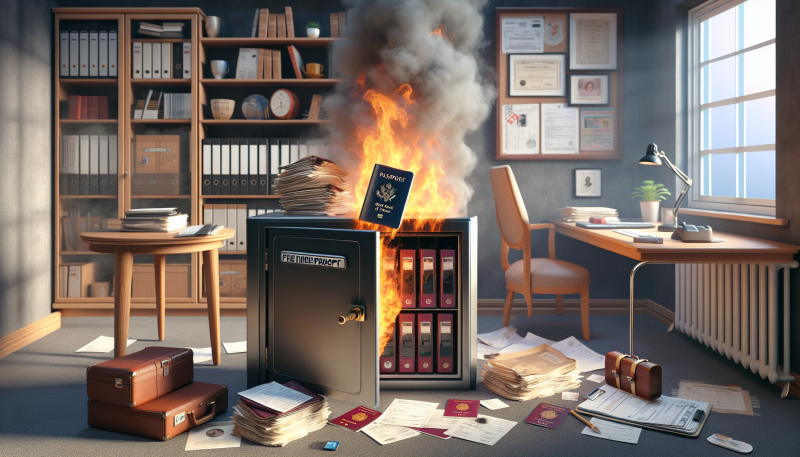Fire Damage: Protecting Important Documents
Fire damage can be devastating, not only to your property but also to the important documents that hold significant value in your life. Protecting these crucial papers, such as birth certificates, legal documents, and financial records, is essential in the aftermath of a fire. At Kraus Restoration, NJ’s leaders in water, mold, and fire damage restoration, we understand the importance of safeguarding your vital information. Our team of IICRC certified experts is dedicated to providing rapid response and 24/7 emergency services to help you recover from fire incidents effectively. Serving Central and Northern NJ, we are here to guide you through the process of document protection and restoration. Don’t wait until it’s too late—call us at (973) 886-2021 to learn how to secure your important documents against fire damage.
Understanding the Risks of Fire Damage to Documents
Fire damage poses a significant threat to important documents, which can include everything from personal records and legal papers to cherished photographs and historical artifacts. Understanding the risks associated with fire damage is crucial for anyone looking to protect their valuable documents. Fires can occur unexpectedly, and the aftermath can be devastating, not just physically but also emotionally, especially when irreplaceable items are lost.
The primary risk of fire damage to documents lies in the intense heat and flames that can quickly consume paper and other materials. According to the National Fire Protection Association (NFPA), in 2020, U.S. fire departments responded to an estimated 1.4 million fires, resulting in billions of dollars in property damage. This statistic underscores the reality that fires can happen anywhere, at any time, and the consequences can be catastrophic.
When documents are exposed to fire, they can suffer from direct burning, which can lead to complete destruction. However, even documents that are not directly engulfed in flames can be severely damaged by heat, smoke, and water used to extinguish the fire. High temperatures can cause paper to become brittle and disintegrate, while smoke can leave behind soot and residues that can stain and degrade the material. Water damage from firefighting efforts can also lead to mold growth, further compromising the integrity of the documents.
It is essential to recognize that not all documents are created equal when it comes to fire resistance. For instance, standard paper documents are highly susceptible to fire, while materials like metal or certain plastics may withstand higher temperatures. However, even fire-resistant materials can be compromised under extreme conditions. Therefore, it is vital to assess the types of documents you have and their vulnerability to fire damage.
To mitigate the risks of fire damage to your documents, consider the following strategies:
- Store Documents Properly: Use fireproof safes or cabinets to store important documents. These containers are designed to withstand high temperatures and can provide a critical layer of protection.
- Digitize Important Records: Create digital copies of important documents. This not only protects against fire damage but also makes it easier to access and share information when needed.
- Implement a Fire Safety Plan: Regularly review and practice your fire safety plan. Ensure that all household members know what to do in case of a fire and where important documents are stored.
- Regularly Back Up Digital Files: Use cloud storage or external hard drives to back up digital documents. This ensures that even if physical copies are lost, you still have access to essential information.
- Consider Fire Sprinkler Systems: Installing fire sprinkler systems can help control fires before they escalate, reducing the risk of damage to your documents.
In addition to these preventive measures, it is crucial to have a plan in place for recovery in the event of fire damage. Engaging professionals who specialize in fire cleanup can help salvage documents that have been affected by fire, smoke, or water. These experts utilize specialized techniques to restore damaged items, which can be invaluable in preserving your important records.
Moreover, understanding the emotional impact of losing important documents cannot be overstated. As noted by the American Red Cross, “The loss of personal items can be just as devastating as the loss of a home.” This highlights the importance of taking proactive steps to protect your documents, as they often hold sentimental value beyond their physical form.
In conclusion, the risks of fire damage to documents are significant and multifaceted. By recognizing these risks and implementing effective protection strategies, you can safeguard your important records against the devastating effects of fire. Whether through proper storage, digitization, or professional restoration services, taking action now can help ensure that your valuable documents remain safe and secure in the face of potential fire hazards. For more information on protecting your property and documents, visit our about page or explore our services for comprehensive fire damage solutions.
Essential Steps for Document Protection Before a Fire
Protecting important documents from fire damage is a crucial step in safeguarding your personal and professional life. Fires can occur unexpectedly, and the loss of vital documents can lead to significant challenges in recovery and rebuilding. To ensure your documents remain safe, it is essential to take proactive measures before a fire occurs. Here are some essential steps to help you protect your important documents effectively.
First, consider digitizing your important documents. Scanning and saving documents in a secure cloud storage system can provide a backup that is easily accessible from anywhere. This includes essential papers such as birth certificates, social security cards, financial records, and legal documents. By having digital copies, you can quickly retrieve information without the need for physical documents, which can be lost or destroyed in a fire. Make sure to use reputable cloud services that offer encryption and strong security measures to protect your data.
Next, invest in a fireproof safe. A high-quality fireproof safe can withstand extreme temperatures and protect your documents from fire damage. When choosing a safe, look for one that is rated for at least one hour of fire resistance and is large enough to accommodate all your important papers. Store documents such as wills, insurance policies, and property deeds in the safe. Additionally, ensure that the safe is placed in a location that is easily accessible but not in a high-risk area, such as near a fireplace or kitchen.
Another effective strategy is to create a document inventory. This involves listing all important documents and their locations, whether they are stored physically or digitally. Having an inventory can help you quickly identify what you need to recover after a fire. Keep this list in a safe place, preferably in your fireproof safe or as a digital file in your cloud storage. Regularly update this inventory to reflect any changes, such as new documents or changes in storage locations.
Consider using fire-resistant document bags or envelopes for additional protection. These bags are designed to withstand high temperatures and can provide an extra layer of security for your most critical documents. Store these bags in your fireproof safe or in a secure location within your home. This way, even if a fire occurs, your documents will have a better chance of surviving the heat.
It is also wise to keep copies of important documents outside your home. This could be in a safety deposit box at a bank or with a trusted friend or family member. By having copies stored in a different location, you can ensure that you have access to essential documents even if your home is damaged by fire. This step is particularly important for irreplaceable items such as family heirlooms or historical documents.
Regularly review and update your document protection plan. As your life changes, so do your document needs. New purchases, changes in family status, or the acquisition of new assets can all necessitate updates to your document inventory and storage solutions. Make it a habit to review your document protection strategy at least once a year to ensure that it remains effective.
Lastly, educate your family members about the importance of document protection. Ensure that everyone in your household knows where important documents are stored and understands the steps to take in case of a fire. This knowledge can be invaluable during an emergency, allowing for a quicker response and better chances of saving important items.
By taking these essential steps for document protection before a fire, you can significantly reduce the risk of losing vital information. Implementing a combination of digital backups, physical safes, and external storage solutions will provide a comprehensive approach to safeguarding your important documents. For more information on how to protect your home and belongings from fire damage, visit our fire cleanup services or learn more about our company and our commitment to helping you recover from disasters. If you have any questions or need assistance, feel free to contact us today.
Best Practices for Storing Important Documents Safely
When it comes to protecting important documents from fire damage, implementing best practices for storage is essential. Fire can strike unexpectedly, and the loss of vital records can have devastating consequences. To ensure that your documents remain safe, consider a multi-faceted approach that includes both physical and digital storage solutions.
First and foremost, choose the right storage location. Ideally, important documents should be kept in a fireproof safe. These safes are designed to withstand high temperatures and protect contents from flames and smoke. Look for safes that are rated for at least one hour of fire resistance, as this provides a significant buffer during a fire emergency. Additionally, ensure that the safe is waterproof, as water damage from firefighting efforts can also ruin documents. For those who prefer a more accessible option, consider using a fire-resistant file cabinet, which can offer similar protection while allowing for easier access to your documents.
In addition to physical storage, digitizing important documents is a highly effective way to safeguard them against fire damage. Scanning documents and storing them in a secure cloud service or on an external hard drive ensures that you have backup copies available in case of an emergency. When choosing a cloud service, prioritize those that offer strong encryption and data protection measures. Regularly update your digital backups to include any new or modified documents, and consider using a reliable fire cleanup service to assist in recovery efforts if needed.
Organizing your documents is another critical aspect of safe storage. Create a systematic filing system that categorizes documents by type, such as legal, financial, medical, and personal records. This organization not only makes it easier to find documents when needed but also helps you identify which items are most critical to protect. Consider creating a master list of all important documents, including their locations, so that you can quickly assess what you have in case of an emergency.
For those who have valuable items such as heirlooms, certificates, or irreplaceable photographs, consider using archival-quality materials for storage. Acid-free folders and boxes can help prevent deterioration over time, ensuring that your documents remain in good condition. Additionally, keep these items in a separate fireproof safe or cabinet to provide an extra layer of protection.
Regularly reviewing and updating your document storage practices is also essential. Set a schedule to go through your important documents at least once a year. This review should include checking the condition of physical documents, updating digital backups, and ensuring that your storage solutions are still effective. If you have moved or made changes to your living situation, reassess your storage locations to ensure they remain secure.
Lastly, educate your family members about the importance of document safety. Make sure that everyone knows where important documents are stored and how to access them in case of an emergency. This knowledge can be invaluable during a crisis, allowing for a quicker response and minimizing the risk of losing critical information.
By following these best practices for storing important documents safely, you can significantly reduce the risk of loss due to fire damage. Whether you choose to rely on physical storage solutions, digital backups, or a combination of both, the key is to remain proactive and vigilant. For more information on protecting your property from fire damage, consider exploring our services and resources. Remember, the time and effort you invest in safeguarding your important documents today can save you from significant stress and loss in the future.
Fireproof Safes: Choosing the Right One for Your Needs
When it comes to safeguarding your important documents from fire damage, investing in a fireproof safe is a crucial step. Fireproof safes are designed to withstand high temperatures and protect your valuable items, such as legal documents, financial records, and personal mementos, from the devastating effects of fire. However, with a variety of options available on the market, choosing the right fireproof safe for your needs can be overwhelming. Here are some key factors to consider when selecting a fireproof safe that will best protect your important documents.
First and foremost, consider the fire rating of the safe. Fire ratings indicate how long a safe can withstand high temperatures before the interior reaches a critical temperature that could damage its contents. Common fire ratings include 30 minutes, 1 hour, and 2 hours. For most personal documents, a safe with a 1-hour fire rating is sufficient, but if you have particularly valuable or irreplaceable items, you may want to opt for a safe with a longer rating. Always check the manufacturer’s specifications to ensure that the safe meets recognized standards, such as those set by Underwriters Laboratories (UL).
Next, assess the size and capacity of the safe. Think about the types and quantities of documents you need to store. If you have a large collection of files, you will need a safe with ample space. Additionally, consider whether you want to store other items, such as digital media or jewelry, alongside your documents. Fireproof safes come in various sizes, from small portable models to larger, more robust options. Make sure to choose a safe that fits your storage needs while also being manageable for your space.
Another important factor is the locking mechanism. Fireproof safes can come with different types of locks, including key locks, combination locks, and electronic locks. Each type has its advantages and disadvantages. Key locks are simple and reliable but can be lost or stolen. Combination locks provide a higher level of security but require you to remember the combination. Electronic locks offer convenience and quick access but may require battery replacements. Choose a locking mechanism that aligns with your security preferences and ease of use.
Additionally, consider the safe’s construction and materials. A well-constructed fireproof safe should have a solid steel body and a fire-resistant insulation layer. Look for safes that are tested and certified for fire resistance, as this ensures that they have been rigorously evaluated for their ability to withstand extreme heat. The quality of materials used in the safe’s construction will directly impact its durability and effectiveness in protecting your documents.
Portability is another aspect to think about. If you plan to move your safe frequently or want to keep it in a specific location, consider a model that is lightweight and easy to transport. However, keep in mind that lighter safes may not offer the same level of fire protection as heavier models. If you choose a heavier safe, ensure that it is securely anchored to prevent theft.
Lastly, budget is an essential consideration. Fireproof safes come in a wide range of prices, so it is important to determine how much you are willing to invest in protecting your important documents. While it may be tempting to go for the cheapest option, remember that a higher-quality safe will provide better protection and peace of mind in the long run. Look for safes that offer a good balance between price and features, ensuring that you get the best value for your investment.
In conclusion, selecting the right fireproof safe is a vital step in protecting your important documents from fire damage. By considering factors such as fire rating, size, locking mechanism, construction, portability, and budget, you can make an informed decision that meets your specific needs. For more information on protecting your home and belongings from fire damage, visit our about page or explore our fire cleanup services. Remember, investing in a quality fireproof safe is an investment in the security of your most valuable documents.
Digital Backup Solutions for Important Documents
In today’s digital age, safeguarding important documents is more crucial than ever, especially in the face of potential disasters such as fire damage. Digital backup solutions provide a reliable way to ensure that your vital records remain intact and accessible, even if physical copies are lost or destroyed. These solutions encompass a variety of methods and technologies designed to create secure digital copies of essential documents, including legal papers, financial records, medical files, and personal memorabilia. By utilizing digital backup solutions, individuals and businesses can mitigate the risks associated with fire damage and other unforeseen events.
One of the primary advantages of digital backup solutions is their ability to offer redundancy. Unlike physical documents that can be easily damaged or destroyed, digital files can be stored in multiple locations, both on-site and off-site. Cloud storage services, for example, allow users to upload their documents to secure servers, ensuring that even if a fire were to occur at their primary location, their important files would remain safe and retrievable from any internet-connected device. This level of accessibility is invaluable, particularly in emergencies when time is of the essence.
Moreover, digital backup solutions often come with advanced security features that protect sensitive information from unauthorized access. Encryption, password protection, and two-factor authentication are just a few of the measures that can be implemented to safeguard your documents. This is especially important for personal and financial records, where privacy and security are paramount. By choosing a reputable digital backup service, users can rest assured that their information is protected against both physical threats, such as fire, and digital threats, such as hacking.
In addition to security and redundancy, digital backup solutions also enhance organization and efficiency. Digital files can be easily categorized, searched, and retrieved, making it simple to find specific documents when needed. This is a stark contrast to physical documents, which can become disorganized or misplaced over time. With digital backups, users can create a structured filing system that allows for quick access to important information, streamlining processes for both personal and business needs.
Implementing a digital backup solution is straightforward and can be tailored to fit individual needs. Many services offer user-friendly interfaces that guide users through the process of uploading and organizing their documents. Additionally, regular backups can be scheduled to ensure that new documents are consistently saved, providing peace of mind that nothing important will be overlooked. For those who may not be tech-savvy, there are numerous resources available, including professional services that can assist with the setup and management of digital backups.
It is also essential to consider the long-term benefits of digital backup solutions. As technology continues to evolve, the methods for storing and accessing information will only improve. By adopting digital backup solutions now, individuals and businesses can future-proof their document management strategies, ensuring that they remain resilient against potential threats. This proactive approach not only protects important documents from fire damage but also prepares users for the digital landscape of tomorrow.
In conclusion, digital backup solutions are an indispensable tool for protecting important documents from fire damage and other disasters. By leveraging the power of technology, individuals and businesses can create secure, organized, and easily accessible digital copies of their vital records. The combination of redundancy, security, and efficiency makes digital backups a smart choice for anyone looking to safeguard their important information. To learn more about how to protect your documents and explore additional services, visit our about page or check out our services for comprehensive solutions tailored to your needs. If you have any questions or need assistance, feel free to contact us for expert guidance.
What to Do After a Fire: Recovering Damaged Documents
Experiencing a fire can be devastating, not only due to the physical damage to your property but also because of the potential loss of important documents. After a fire, recovering damaged documents is a critical step in the recovery process. The first thing to do is to assess the extent of the damage. Carefully examine all documents that were affected by the fire, smoke, or water used to extinguish the flames. This includes personal identification documents, financial records, legal papers, and sentimental items such as photographs.
Once you have identified the damaged documents, it is essential to prioritize them based on their importance. For example, documents like birth certificates, passports, and insurance policies should be at the top of your list, as they are crucial for identity verification and filing claims. If any documents are completely destroyed, you will need to contact the relevant authorities or institutions to obtain replacements. This may involve visiting government offices, banks, or other organizations to request new copies.
For documents that are partially damaged, there are several methods you can use to recover them. If the documents are wet, it is important to handle them carefully to avoid further damage. You can lay them flat on a clean surface and allow them to air dry. If they are stuck together, do not force them apart, as this can cause tearing. Instead, you can place them in the freezer to prevent mold growth until you are ready to separate them.
For documents that have been charred or burned, recovery can be more challenging. In some cases, professional restoration services may be necessary. These experts can use specialized techniques to salvage and restore important documents. If you are considering this option, look for a company that specializes in fire damage recovery, such as fire cleanup services, which can provide the expertise needed to restore your documents safely.
In addition to physical recovery, it is also important to consider digital backups. If you have scanned copies of your important documents stored on a cloud service or external hard drive, you may be able to recover them without any issues. If you do not have digital backups, this experience serves as a reminder of the importance of maintaining electronic copies of your important documents. Moving forward, consider creating digital backups of all vital records to ensure that you have access to them in case of future emergencies.
Once you have recovered your documents, it is advisable to keep them in a safe place. Consider investing in a fireproof safe or a safety deposit box to protect your important papers from future incidents. Additionally, regularly review and update your important documents to ensure that you have the most current information available.
Finally, do not hesitate to reach out for support during this challenging time. Organizations and professionals specializing in disaster recovery can provide guidance and assistance in navigating the recovery process. Whether you need help with document recovery or emotional support, there are resources available to help you through this difficult experience. For more information on recovery services, you can visit our services page.
Recovering from a fire is a complex process, but with careful planning and the right resources, you can successfully restore your important documents and move forward. Remember to take your time, seek professional help when needed, and prioritize your recovery efforts. By doing so, you can ensure that you have the necessary documentation to rebuild your life after a fire.
Creating a Fire Safety Plan for Your Important Papers
Creating a fire safety plan for your important papers is a crucial step in safeguarding your most valuable documents from the devastating effects of fire damage. Fires can occur unexpectedly, and the loss of essential documents can be both emotionally and financially devastating. Therefore, having a well-thought-out plan can help ensure that your important papers are protected and can be recovered in the event of a fire.
First, it is essential to identify which documents are most important to you. This may include legal documents such as birth certificates, marriage licenses, wills, insurance policies, financial records, and medical records. Once you have a comprehensive list, consider the best methods for protecting these documents. One effective strategy is to invest in a fireproof safe. These safes are specifically designed to withstand high temperatures and protect your documents from fire damage. When selecting a safe, ensure it is rated for fire resistance and large enough to accommodate all your important papers.
In addition to using a fireproof safe, consider digitizing your important documents. Scanning and storing your documents in a secure cloud storage service can provide an additional layer of protection. This way, even if your physical documents are lost in a fire, you will still have access to digital copies. Make sure to use strong passwords and two-factor authentication for your online storage to enhance security. Regularly back up your digital files to ensure that you have the most current versions available.
Another critical aspect of your fire safety plan should involve regular reviews and updates. Life changes, such as marriage, the birth of a child, or the purchase of a new home, can affect which documents are important. Schedule a time each year to review your list of important papers and update your fire safety plan accordingly. This will help you stay organized and ensure that your plan remains effective.
It is also advisable to educate your family members about the fire safety plan. Ensure that everyone knows where the fireproof safe is located and how to access it in case of an emergency. Conduct fire drills that include retrieving important documents from the safe, so everyone is familiar with the process. This practice can help reduce panic during a real emergency and ensure that your important papers are secured quickly.
In addition to protecting your documents, consider implementing other fire safety measures in your home. Install smoke detectors on every level of your home and test them regularly to ensure they are functioning correctly. Create and practice an escape plan that includes a designated meeting place outside your home. This plan should be communicated to all family members, ensuring everyone knows what to do in case of a fire.
Lastly, consider consulting with fire safety professionals to assess your home and provide recommendations tailored to your specific needs. They can offer insights into fire prevention strategies and help you create a comprehensive fire safety plan that includes protecting your important documents. For more information on fire safety and restoration services, you can visit our fire cleanup page.
By taking these proactive steps to create a fire safety plan for your important papers, you can significantly reduce the risk of losing valuable documents in a fire. Remember that preparation is key, and having a solid plan in place can provide peace of mind knowing that your important papers are protected. For additional resources on protecting your home and documents, feel free to explore our about page or reach out through our contact page for personalized assistance.
In conclusion, protecting important documents from fire damage is not just a precaution; it’s a necessity. By taking proactive steps such as creating digital backups, using fireproof storage solutions, and developing a comprehensive emergency plan, you can safeguard your invaluable records against the unpredictable nature of fire. Remember, preparation is key. Regularly review and update your document protection strategies to ensure they remain effective. By prioritizing the safety of your important documents, you can have peace of mind knowing that your vital information is secure, even in the face of disaster. Don’t wait for a fire to strike—act now to protect what matters most.










